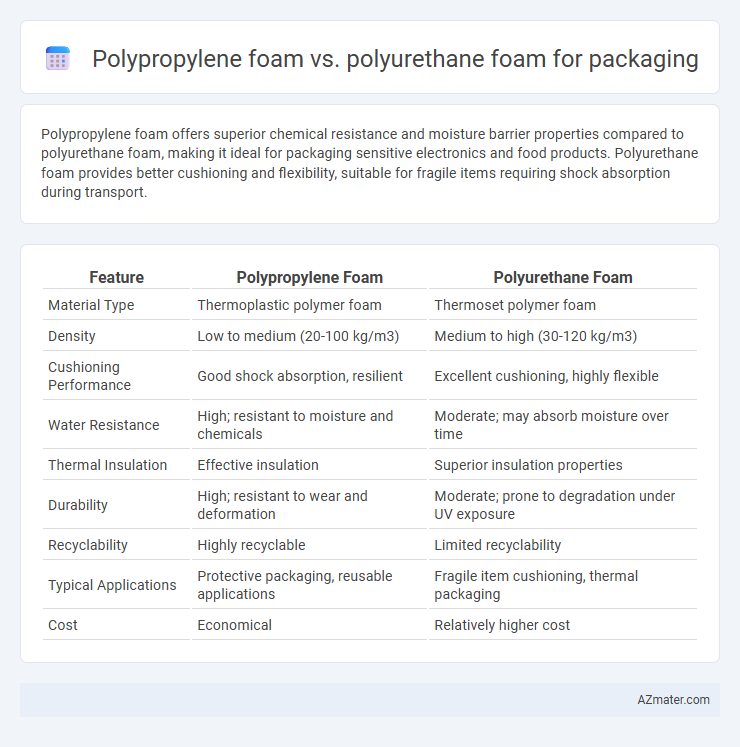Polypropylene foam offers superior chemical resistance and moisture barrier properties compared to polyurethane foam, making it ideal for packaging sensitive electronics and food products. Polyurethane foam provides better cushioning and flexibility, suitable for fragile items requiring shock absorption during transport.
Table of Comparison
| Feature | Polypropylene Foam | Polyurethane Foam |
|---|---|---|
| Material Type | Thermoplastic polymer foam | Thermoset polymer foam |
| Density | Low to medium (20-100 kg/m3) | Medium to high (30-120 kg/m3) |
| Cushioning Performance | Good shock absorption, resilient | Excellent cushioning, highly flexible |
| Water Resistance | High; resistant to moisture and chemicals | Moderate; may absorb moisture over time |
| Thermal Insulation | Effective insulation | Superior insulation properties |
| Durability | High; resistant to wear and deformation | Moderate; prone to degradation under UV exposure |
| Recyclability | Highly recyclable | Limited recyclability |
| Typical Applications | Protective packaging, reusable applications | Fragile item cushioning, thermal packaging |
| Cost | Economical | Relatively higher cost |
Introduction to Polypropylene and Polyurethane Foams
Polypropylene foam is a lightweight, closed-cell material renowned for its high chemical resistance, excellent durability, and impact absorption, making it ideal for protective packaging applications. Polyurethane foam features an open-cell structure with superior cushioning properties and flexibility, commonly used for fragile item packaging and shock absorption. Both foams offer distinct benefits, with polypropylene excelling in moisture resistance and polyurethane in comfort and adaptability.
Chemical Composition and Manufacturing Processes
Polypropylene foam is produced through polymerization of propylene monomers, forming a thermoplastic polymer characterized by a linear hydrocarbon chain with methyl side groups, which provides excellent chemical resistance and high thermal stability. Polyurethane foam results from a chemical reaction between polyols and diisocyanates, creating a polymer with urethane linkages that offers superior flexibility and cushioning properties. Manufacturing polypropylene foam typically involves extrusion or bead expansion techniques, while polyurethane foam is commonly produced via reaction injection molding or slabstock processes, leading to differences in cell structure and performance in packaging applications.
Physical Properties Comparison
Polypropylene foam exhibits higher chemical resistance and greater durability compared to polyurethane foam, making it ideal for packaging applications requiring long-term protection and moisture resistance. Polyurethane foam offers superior cushioning and compression recovery, providing excellent shock absorption and impact protection for fragile items. Density variations in polypropylene foam generally range from 20 to 50 kg/m3, while polyurethane foam densities vary widely from 25 to 100 kg/m3, influencing their flexibility and load-bearing capabilities in packaging solutions.
Cushioning and Impact Resistance
Polypropylene foam offers excellent cushioning and impact resistance due to its closed-cell structure, providing superior energy absorption and durability for protecting sensitive items during shipping. Polyurethane foam, characterized by its open-cell composition, delivers softer cushioning but may compress more easily under impact, making it suitable for lighter, less fragile products. Both foams excel in shock absorption, but polypropylene foam is favored for heavy-duty packaging requiring long-term resilience and moisture resistance.
Weight and Density Considerations
Polypropylene foam offers a lower density range of 20-60 kg/m3 compared to polyurethane foam, which typically ranges from 30-80 kg/m3, making polypropylene foam significantly lighter for packaging applications. The reduced weight of polypropylene foam enhances shipping efficiency and lowers transportation costs while maintaining adequate cushioning properties. Polyurethane foam, though denser, provides superior energy absorption but increases overall package weight, impacting logistics and material handling.
Moisture and Chemical Resistance
Polypropylene foam offers superior moisture resistance compared to polyurethane foam, making it ideal for packaging applications requiring protection against water and humidity. Its closed-cell structure prevents water absorption and maintains cushioning performance in damp environments. Polyurethane foam, while providing excellent cushioning, is more susceptible to chemical degradation and moisture absorption, which can compromise packaging integrity over time.
Environmental Impact and Sustainability
Polypropylene foam offers superior environmental benefits compared to polyurethane foam due to its higher recyclability and lower carbon footprint in production. Polyurethane foam, while effective in cushioning, often contains toxic chemicals and poses challenges in waste management and biodegradability. Choosing polypropylene foam supports sustainability goals by reducing landfill waste and promoting circular economy practices in packaging.
Cost Effectiveness in Packaging Applications
Polypropylene foam offers superior cost-effectiveness in packaging applications due to its lower material and production costs compared to polyurethane foam. Its lightweight nature reduces shipping expenses while maintaining adequate impact resistance, making it ideal for bulk packaging. Polyurethane foam, although providing higher cushioning performance, generally incurs higher costs, limiting its use to premium or fragile product protection where budget constraints are less stringent.
Common Use Cases in Packaging
Polypropylene foam is widely used for packaging fragile electronics, medical devices, and automotive parts due to its excellent impact resistance and chemical stability. Polyurethane foam is preferred for packaging delicate items like glassware, furniture, and consumer goods because of its superior cushioning properties and flexibility. Both foams offer lightweight protection, but polypropylene foam excels in reusable and moisture-resistant applications, whereas polyurethane foam is favored for disposable packaging and shock absorption.
Choosing the Right Foam: Key Factors to Consider
When choosing between polypropylene foam and polyurethane foam for packaging, consider factors such as density, durability, and chemical resistance. Polypropylene foam offers excellent impact absorption, moisture resistance, and thermal stability, making it ideal for heavy-duty or moisture-sensitive products. Polyurethane foam provides superior cushioning and flexibility, suitable for fragile items requiring delicate protection during transit.

Infographic: Polypropylene foam vs Polyurethane foam for Packaging
 azmater.com
azmater.com